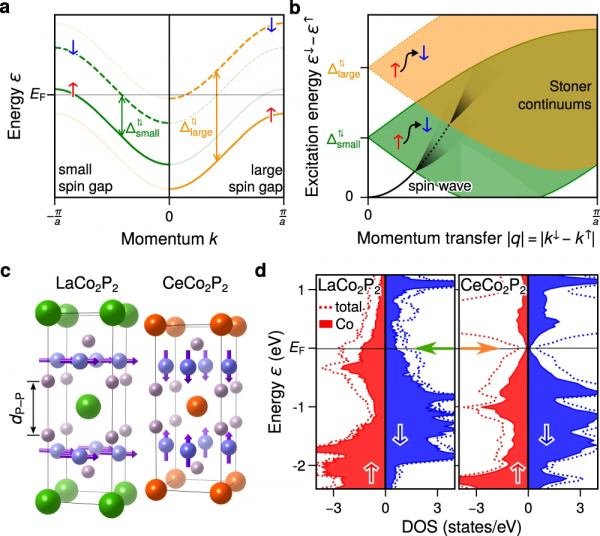Long-lived spin waves in a metallic antiferromagnet
A metallic antiferromagnet CeCo2P2 is sustaining long-lived terahertz magnons due to suppressed low-energy spin-flip excitations, as shown by first-principle calculations and resonant inelastic X-ray scattering. Our findings highlight the potential for bulk metallic systems to support undamped terahertz magnons, promising for next-generation spintronic devices.
Collective spin excitations in magnetically ordered crystals, called magnons or spin waves, can serve as carriers in novel spintronic devices with ultralow energy consumption. The generation of well-detectable spin flows requires long lifetimes of high-frequency magnons. In general, the lifetime of spin waves in a metal is substantially reduced due to a strong coupling of magnons to the Stoner continuum. This makes metals unattractive for use as components for magnonic devices. Here, we present the metallic antiferromagnet CeCo2P2, which exhibits long-living magnons even in the terahertz (THz) regime. For CeCo2P2, our first-principle calculations predict a suppression of low-energy spin-flip Stoner excitations, which is verified by resonant inelastic X-ray scattering measurements. By comparison to the isostructural compound LaCo2P2, we show how small structural changes can dramatically alter the electronic structure around the Fermi level leading to the classical picture of the strongly damped magnons intrinsic to metallic systems. Our results not only demonstrate that long-lived magnons in the THz regime can exist in bulk metallic systems, but they also open a path for an efficient search for metallic magnetic systems in which undamped THz magnons can be excited.

Figure: a Metallic band structure of a spin-split band for a small and large spin (Stoner) gap. b Relationship between the corresponding Stoner continuum and the onset of the spin wave scattering. Larger spin gaps promote undamped spin waves up to higher energies. c Crystal structure of LaCo2P2 and CeCo2P2 with the reduced distance and larger magnetic exchange between Co layers in CeCo2P2. d Spin-resolved density of states in LaCo2P2 and CeCo2P2.



